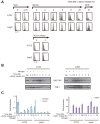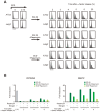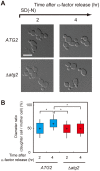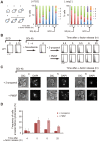The role of autophagy in genome stability through suppression of abnormal mitosis under starvation
- PMID: 23382696
- PMCID: PMC3561091
- DOI: 10.1371/journal.pgen.1003245
The role of autophagy in genome stability through suppression of abnormal mitosis under starvation
Abstract
The coordination of subcellular processes during adaptation to environmental change is a key feature of biological systems. Starvation of essential nutrients slows cell cycling and ultimately causes G1 arrest, and nitrogen starvation delays G2/M progression. Here, we show that budding yeast cells can be efficiently returned to the G1 phase under starvation conditions in an autophagy-dependent manner. Starvation attenuates TORC1 activity, causing a G2/M delay in a Swe1-dependent checkpoint mechanism, and starvation-induced autophagy assists in the recovery from a G2/M delay by supplying amino acids required for cell growth. Persistent delay of the cell cycle by a deficiency in autophagy causes aberrant nuclear division without sufficient cell growth, leading to an increased frequency in aneuploidy after refeeding the nitrogen source. Our data establish the role of autophagy in genome stability through modulation of cell division under conditions that repress cell growth.
Conflict of interest statement
The authors have declared that no competing interests exist.
Figures








References
-
- Tsukada M, Ohsumi Y (1993) Isolation and characterization of autophagy-defective mutants of Saccharomyces cerevisiae . FEBS Lett 333: 169–174. - PubMed
-
- Thumm M, Egner R, Koch B, Schlumpberger M, Straub M, et al. (1994) Isolation of autophagocytosis mutants of Saccharomyces cerevisiae . FEBS Lett 349: 275–280. - PubMed
-
- Nakatogawa H, Suzuki K, Kamada Y, Ohsumi Y (2009) Dynamics and diversity in autophagy mechanisms: lessons from yeast. Nat Rev Mol Cell Biol 10: 458–467. - PubMed
-
- Mizushima N (2007) Autophagy: process and function. Genes Dev 21: 2861–2873. - PubMed
-
- Oku M, Sakai Y (2008) Pexophagy in Pichia pastoris. Methods Enzymol 451: 217–228. - PubMed
Publication types
MeSH terms
Substances
LinkOut - more resources
Full Text Sources
Other Literature Sources
Molecular Biology Databases

